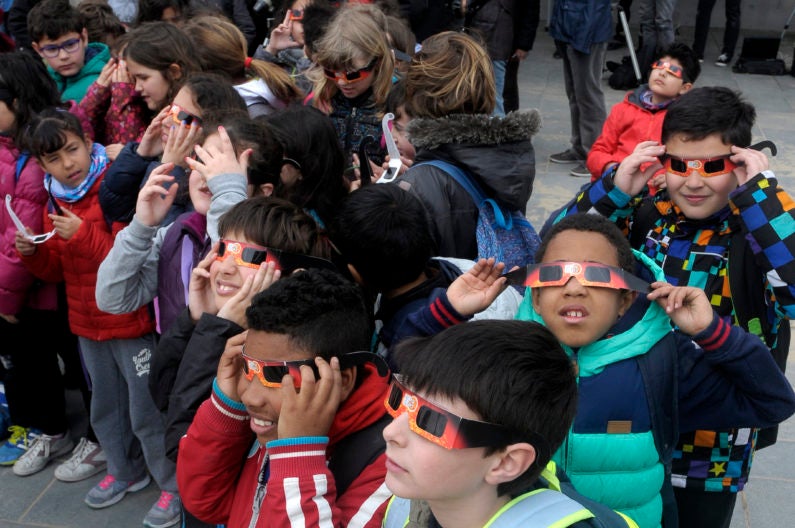Stanford educators suggest hands-on lessons to bring the solar eclipse into the classroom
Stanford education faculty suggest ways for teachers and parents to take advantage of the solar eclipse on Aug. 21.
As teachable moments go, it’s an extraordinary one: Aug. 21 marks the first time in nearly a century that a total solar eclipse will span the entire United States.

Children wear special protective glasses while watching a solar eclipse in Barcelona, Spain, in 2015. (Image credit: Alberto Roura / Getty Images)
“For most of us, this is a once-in-a-lifetime opportunity,” said Jonathan Osborne, the Kamalachari Professor of Science Education at Stanford Graduate School of Education (GSE). “For young children, it’s also a great stimulus to their curiosity.”
The event, Osborne said, prompts many kids to question why the universe works the way it does: Are the moon and the sun really the same size? Why isn’t everyone on Earth seeing this at the same time? How can we predict so accurately when it’s going to happen?
“Questions like this drive science,” said Osborne, whose research includes investigating how to help students use evidence to argue scientific concepts. “Answering these questions often requires us to imagine the world not as it appears to be and then develop an idea that explains it.”
Making science accessible
Students of any age can participate in lessons around the event. Many schools will be in session by then, though some have postponed their opening day so that students can witness the occurrence with their families.
The path of totality – where observers see the moon completely cover the sun – will pass through parts of only 14 states. But weather permitting, people in every state will see at least a partial eclipse. (Of course, no one should look directly at it without a certified solar filter or viewer sold by a reputable vendor.)
The perceptible impact of the eclipse makes it a relatively approachable scientific subject for both children and adults, said Bryan Brown, an associate professor of science education and associate dean for student affairs at GSE.
“Some science phenomena are abstract and you have to think hard to imagine their implications,” Brown said. “But when you’re experiencing an eclipse, you’re experiencing movement in the universe. It’s not an abstract thing.”
For lesson ideas and other guidance, Brown and Osborne suggest that adults take advantage of resources available online through NASA and popular television personalities like Bill Nye and Steve Spangler.
“People have this idea that only scientists can teach kids science,” said Brown, who also directs a one-week summer science camp for inner-city students in the San Francisco Bay Area. “But there are ways to become science teachers at home.”
Projects for young learners
Eclipse-related educational activities naturally tend to focus on science and math: solar viewer construction, mathematical challenges, solar system modeling and so on. But projects that involve geography, history and social studies – like working with eclipse maps and reading accounts of eclipses from ancient civilizations – are also relevant. Students can even be encouraged to explore literature, music and other art inspired by celestial bodies and events.
Those fortunate enough to be in the path of totality can also participate in real-time scientific experimentation. With total coverage, for example, observers will experience a sudden, marked change in the temperature due to the loss of light.
“If you have a thermometer that responds rapidly,” Osborne said, “it’s worth measuring the drop in temperature.” If not, he said, students can still track how long the change lasts.
“The main thing is to listen,” Osborne said. “If there are a lot of insects and animal life, they all go very quiet.”
Ultimately, Brown said, the experience can inspire in youngsters a more palpable sense of the space they occupy in the world.
“We get a chance to see how we fit relative to the rest of the universe,” Brown said. “It’s a great cosmic experience – the only one we can experience without going anywhere.”
